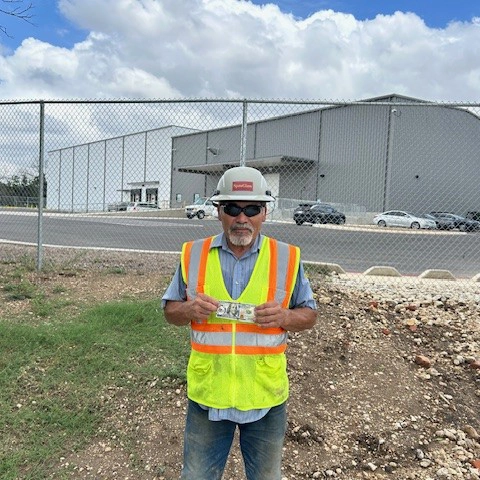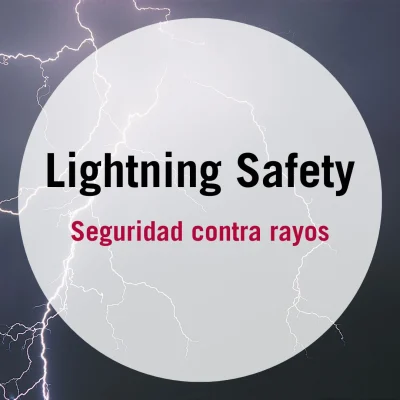100 DAYS OF SUMMER
Each year, SpawGlass launches our “100 Days of Summer” campaign from Memorial Day through Labor Day. This initiative highlights seasonal safety issues and rewards team members for going above and beyond to put safety first during the hot summer months.
Scroll down to read about this week’s winner and safety topic!
Week 15 – 100 Days of Summer

100 days of summer - week 15
Congratulations to our Week 15, 100 Days of Summer winner – Justo Parra is celebrating 27 years with SpawGlass and is an Equipment Operator in the San Antonio division.
Felicitaciones a nuestro ganador de la Semana 15, 100 Días de Verano: Justo Parra está celebrando 27 años con SpawGlass y es Operador de Equipos en la división de San Antonio.
SAFETY TIP

Lightning kills about 20 people each year in the United States and hundreds more are injured. Many lightning victims are caught outside during a storm because they did not act promptly to get to a safe place, or they go back outside too soon after a storm has passed. If signs of approaching thunderstorms occur, workers should not begin any task they cannot quickly stop. When thunder roars, go indoors! If you hear thunder, even a distant rumble, get to a safe place immediately.
Thunderstorms always include lightning. Any thunder you hear is caused by lightning! The National Oceanic and Atmospheric Administration (NOAA) advises that nowhere outside is safe when thunderstorms are in your area.
• Get into an enclosed building and do not use plug-in power tools or machines. If you can’t find a building, get into a car or truck with the windows closed. Do not touch the doors or other metal inside. Remain inside for at least 30 minutes after hearing the last sound of thunder.
• Do not be the tallest object in an area. Do not stand out in the open, or on a roof, under a tree or in an open shelter.
• Keep away from water and metal objects—pipes, light poles, door frames, metal fences, communication towers—indoors or out.
• If you are out in the open and have nowhere to go, squat down with your feet together and only let your feet touch the ground. Do not lie flat on the ground. Lightning travels through the ground. The more contact you have, the greater your risk for injury or death. Put your hands over your ears to protect against noise.
Los rayos matan a unas 20 personas cada año en los Estados Unidos y cientos más resultan heridas.
Muchas víctimas de rayos quedan atrapadas afuera durante una tormenta porque no actuaron con prontitud para llegar a un lugar seguro, o vuelven a salir demasiado pronto después de que haya pasado una tormenta. Si se producen signos de tormentas eléctricas que se aproximan, los trabajadores no deben comenzar ninguna tarea que no puedan detener rápidamente.
Cuando ruga el trueno, ¡entra en casa! Si escuchas un trueno, incluso un estruendo distante, ve a un lugar seguro de inmediato. Las tormentas eléctricas siempre incluyen relámpagos.
¡Cualquier trueno que escuches es causado por un rayo! La Administración Nacional Oceánica y Atmosférica (NOAA) aconseja que ningún lugar al aire libre es seguro cuando hay tormentas eléctricas en su área.
• Ingrese a un edificio cerrado y no use herramientas eléctricas o máquinas enchufables. Si no puede encontrar un edificio, suba a un automóvil o camión con las ventanas cerradas. No toque las puertas ni ningún otro metal en el interior. Permanezca adentro durante al menos 30 minutos después de escuchar el último sonido de un trueno.
• No seas el objeto más alto de un área. No se pare al aire libre, ni en un techo, ni debajo de un árbol ni en un refugio abierto.
• Manténgase alejado del agua y de objetos metálicos (tuberías, postes de luz, marcos de puertas, cercas metálicas, torres de comunicación) en interiores o exteriores.
• Si estás al aire libre y no tienes a dónde ir, ponte en cuclillas con los pies juntos y solo deja que los pies toquen el suelo. No se acueste en el suelo. El rayo viaja a través del suelo.
Cuanto más contacto tenga, mayor será su riesgo de lesiones o muerte. Ponte las manos sobre los oídos para protegerte del ruido.

